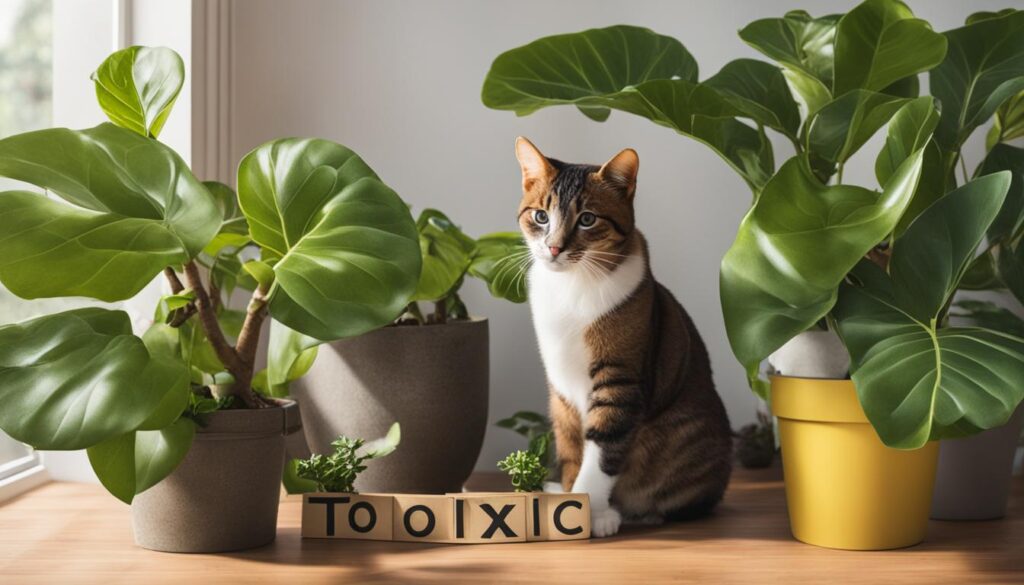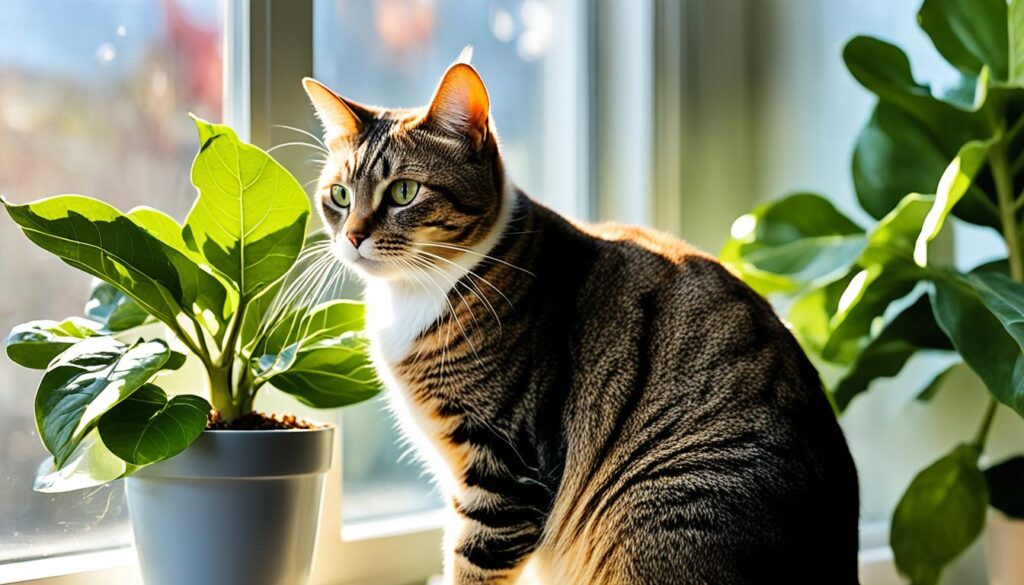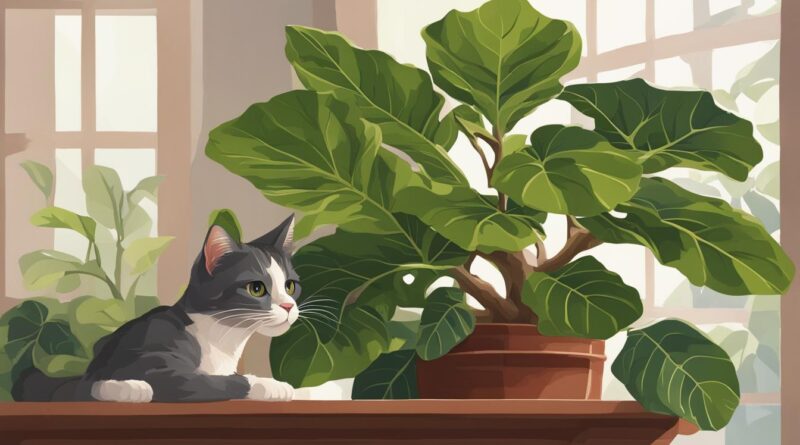Are Fiddle Leaf Figs Toxic to Cats? Safety Tips!
Fiddle leaf figs, also known as Ficus lyrata, are a popular houseplant with unique foliage. They can add a touch of greenery and style to any indoor space. However, if you have a furry feline friend at home, it’s important to be aware of the potential dangers these plants can pose to cats.
While fiddle leaf figs are aesthetically pleasing, they are actually toxic to cats, as well as dogs and humans. The entire plant, including the leaves, stems, and trunks, contains an irritating white sap that can cause oral and skin irritation in cats. Although ingestion of fiddle leaf figs may lead to symptoms such as oral and throat irritation, abdominal pain, and vomiting, they are considered to be only mildly poisonous and rarely result in severe illness or death in pets.
To ensure the safety of feline companions, it’s crucial for cat owners to take precautions and prevent their pets from coming into contact with fiddle leaf figs. By doing so, you can create a pet-friendly environment while still enjoying the beauty of these plants.
Key Takeaways:
- Fiddle leaf figs are toxic to cats, as well as dogs and humans.
- The entire plant, including the leaves, stems, and trunks, contains an irritating white sap that can cause oral and skin irritation in cats.
- Ingestion of fiddle leaf figs may lead to symptoms such as oral and throat irritation, abdominal pain, and vomiting.
- However, fiddle leaf figs are only mildly poisonous and rarely result in severe illness or death in pets.
- Prevent your cat from coming into contact with fiddle leaf figs to ensure their safety.
How Do Fiddle Leaf Figs Affect Cats and Dogs?
When cats or dogs come into contact with fiddle leaf figs, the calcium oxalate crystals present in the sap can scratch and irritate the delicate tissues in their mouth, throat, and stomach.
Symptoms of fiddle leaf fig toxicity in cats and dogs may include:
- Drooling
- Swelling of the mouth, tongue, or lips
- Vomiting
- Appetite loss
- Changes in urination or thirst
- Diarrhea
- In severe cases, breathing difficulties, blood pressure issues, weakness, or lethargy
It is important to monitor pets for any signs of ingestion or contact with the plant and seek veterinary attention if symptoms are observed.

Throughout the course of their interactions with fiddle leaf figs, cats and dogs may experience various discomforting symptoms. The calcium oxalate crystals within the plant’s sap can irritate their mouth, throat, and stomach, leading to issues like drooling, swelling, vomiting, and more. Pet owners must be vigilant in watching for these signs and contacting a veterinarian if necessary.
What to Do If Your Cat Eats a Fiddle Leaf Fig?
If a cat ingests a fiddle leaf fig or comes into contact with the sap, it is important to take immediate action. Cats are curious creatures and may be tempted to explore or nibble on plants, including fiddle leaf figs. To ensure the safety of your feline friend, follow these steps:
- Rinse their mouth: If you notice your cat has chewed on the plant or its leaves, gently rinse their mouth with water. This will help remove any sap residue that might cause further irritation. Use a clean cloth or cotton pad soaked in water to wipe their gums, tongue, and lips.
- Monitor for symptoms: After rinsing their mouth, keep a close eye on your cat for any signs of discomfort or symptoms such as drooling, vomiting, decreased appetite, or difficulty breathing. Symptoms may vary depending on the amount of exposure or ingestion.
- Contact your veterinarian: If your cat exhibits any symptoms or if you suspect they have ingested a significant amount of the fiddle leaf fig, it’s vital to seek guidance from your veterinarian. They will provide you with the best course of action based on your cat’s individual situation.
- Follow veterinarian recommendations: Depending on the severity of the situation, your veterinarian may recommend additional steps to ensure your cat’s well-being. This may include rinsing the mouth further with a veterinary-approved solution, administering gastrointestinal protectants to soothe any discomfort, or running tests to assess any potential organ damage.
Remember, swift action is crucial in situations involving plant ingestion or contact with potentially toxic substances. By following these steps and seeking professional help, you can help protect your cat’s health and well-being.
Fiddle Leaf Fig Safety Tips for Pet Owners
To ensure the safety of your pets and maintain a harmonious living environment with your beloved fiddle leaf figs, it is essential for pet owners to implement some precautionary measures. By taking these steps, you can create a cat-friendly space that brings joy to both you and your furry friends.
1. Keep the plant out of reach
Placement is key. To prevent any unintended encounters between your pets and your fiddle leaf fig, consider placing the plant in a room that is inaccessible to your pets. Alternatively, you can choose to display it on a high shelf, out of the reach of curious paws and whiskers.
2. Use physical barriers
If relocating the plant is not an option, you can use adjustable pet gates or other physical barriers to successfully restrict your pets’ access to the fiddle leaf fig. These barriers create a safe boundary, ensuring that your pets can appreciate the plant from a distance without the temptation to investigate or chew on it.
3. Utilize natural deterrents
Another effective strategy is to use natural deterrents to repel your pets from the plant. Citrus essential oils or ground pepper sprinkled around the base of the plant can help deter cats and dogs from approaching. The smell and taste of these substances are usually unappealing to pets, steering them clear of your fiddle leaf fig.
4. Positive reinforcement training
Teaching your pets to respect the boundaries around your fiddle leaf fig can be achieved through positive reinforcement training. Rewarding your pets with treats or praise when they avoid the plant will help them associate good behavior with staying away from it. Consistency and patience are key in reinforcing these positive habits.
5. Provide distractions and chew toys
Redirecting your pets’ attention is crucial in preventing them from nibbling on your fiddle leaf figs. Offer plenty of alternative distractions and interactive chew toys to keep their focus away from the plant. This will help satisfy their natural chewing instincts and provide an outlet for their energy.

By implementing these cat-friendly fiddle leaf fig safety tips, you can strike a balance between your love for plants and your love for your pets. Creating a safe and harmonious environment within your home will allow you to enjoy both your beautiful fiddle leaf figs and the company of your furry family members.
Conclusion
In conclusion, fiddle leaf figs are toxic to cats and it is important for cat owners to prioritize their pets’ safety when it comes to these popular houseplants. While fiddle leaf figs may cause oral and skin irritation, as well as mild gastrointestinal symptoms in cats, severe illness or death is rare. Nonetheless, taking precautionary measures can help minimize the risk.
Keeping the plant out of reach, either by placing it in an inaccessible room or on a high shelf, is crucial. Physical barriers such as adjustable pet gates can also be used to prevent cats from accessing the plant. Additionally, using natural deterrents like citrus essential oils or pepper can help repel pets. Providing alternative outlets for cats’ chewing instincts, such as chew toys, can redirect their attention away from the plant.
Vigilance is key in ensuring cats’ safety around fiddle leaf figs. Pet owners should monitor their cats for any signs of ingestion or contact with the plant, and if any symptoms occur, it is important to consult with a veterinarian for guidance. By implementing these safety measures, cat owners can enjoy the beauty of fiddle leaf figs while keeping their furry friends safe.
FAQ
Are fiddle leaf figs toxic to cats?
Yes, fiddle leaf figs are toxic to cats. The entire plant, including the leaves, stems, and trunks, contains an irritating white sap that can cause oral and skin irritation in cats.
How do fiddle leaf figs affect cats and dogs?
When cats or dogs come into contact with fiddle leaf figs, the calcium oxalate crystals present in the sap can scratch and irritate the delicate tissues in their mouth, throat, and stomach. Symptoms may include drooling, swelling of the mouth, tongue, or lips, vomiting, appetite loss, and changes in urination or thirst.
What to do if your cat eats a fiddle leaf fig?
If your cat ingests a fiddle leaf fig or comes into contact with the sap, it is important to take immediate action. Rinse their mouth with water and monitor them for symptoms such as drooling, vomiting, decreased appetite, or difficulty breathing. Contact your veterinarian if symptoms occur or if you suspect your cat has ingested a significant amount of the plant.
What are some fiddle leaf fig safety tips for pet owners?
To ensure the safety of cats and fiddle leaf figs, keep the plant out of reach by placing it in a room that is inaccessible to pets or on a high shelf. You can also use physical barriers such as adjustable pet gates, citrus essential oils, or natural deterrents like pepper to repel pets from the plant. Positive reinforcement training techniques and providing pets with distractions and chew toys can also help redirect their attention.
Are fiddle leaf figs safe for cats?
No, fiddle leaf figs are not safe for cats. They are toxic and can cause oral and skin irritation. It is important for cat owners to prevent their pets from coming into contact with the plant or ingesting any part of it to ensure their safety.


